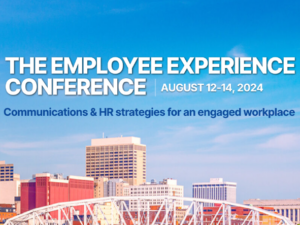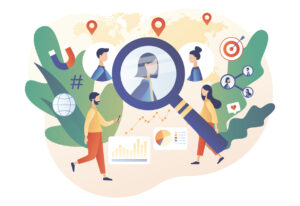4 ways Facebook increased employee engagement with virtual events
Glean the lessons learned after Facebook communicators transformed two annual in-person summits into outstanding digital offerings that drove connection and trust.

Events can provide crucial engagement opportunities for employees adjusting to remote and dispersed workforces during COVID-19.
“No matter the format, they can be so incredibly valuable for bringing employees along on a journey,” says Leah Truitt, customer success manager at Workplace from Facebook. “Now, they’ve truly never been more important.”
Workplace’s annual Transform event—which was held virtually for the first time in the company’s history and brought more than 1,000 people across organizations to collaborate and learn. Though Truitt says the event was a success, changing course from a live event to a virtual offering—while keeping interaction and employee satisfaction high—is a tall task.
“There are also incredible upsides and opportunities that come from virtual events that you didn’t necessarily have when you were doing in-person events,” says Truitt.
Nicole Vendetti, event marketer on Facebook’s global event programs team, and Keith Baker, thought leadership lead on Facebook’s global industry marketing team, were also able to transform Facebook’s annual Global Media Summit. Instead of welcoming roughly 6,500 sales and marketing employees from around the world to a four-day event in San Francisco, Vendetti and Baker turned it into the Un-Summit, a two-day digital experience that delighted and connected the nearly 7,400 employee who attended.
What’s even more impressive? The transformation happened within a month.
“What is usually a nice and leisurely 12-month planning cycle turned into three weeks,” Vendetti says.
Both experiences provided many takeaways and lessons learned for producing events that can engage employees during times of uncertainty.
Consider these four:
1. Think about your audience.
Truitt says that communicators must think differently about the event experience when turning in-person opportunities into virtual experiences. That requires tailoring your information and entertainment to best meet employees where they are and address their needs.
Vendetti and Baker cut a third of the Un-Summit program and shortened session times by nearly 50%. The remaining content was the top information that employees needed and wanted to know, sprinkled with inspirational and feel-good content aimed to uplift and motivate.
“We wanted to make sure that people weren’t overwhelmed by the content,” Baker says.
Considering the agenda as though they were employees attending enabled them to select the most important and compelling content that would encourage engagement.
Baker says:
Our overall goal shifted from an event that provided an opportunity to be together and get inspired to something that was inspiring people to feel together. That became really important to us—that we found ways for people to experience everything together and to feel that although they were distanced, we were all in it together and they were with the people they would normally be with.
Consider internal events as an extension of the employee experience and a tool to delivering the support your workforces needs now more than ever.
2. Ride the video wave—and aim for content that can remain relevant.
Using a combination of conference rooms, internal studios and a few additional locations, Vendetti and Baker turned a four-day live event into a two-day digital production that featured a story and insights spread over seven content blocks, each containing four or five sessions lasting no more than an hour.
They produced a total of 38 video segments within two weeks, which grabbed a total of 36,398 views during the event.
To achieve their success, Vendetti and Baker flexed their content production muscles, looking at the agenda through the lens of digital and broadcast production, creating images to accompany presentations and augmented reality filters to offer additional moments of interaction.
Baker says:
We started to think about ourselves as producing something akin to “Shark Week,” where there was a central theme, but there different “TV show franchises” that would talk in different ways, but would all ladder up to that central theme. We had entertainment that broke things up … We told personal stories that were relevant and inspiring to people, as well as those business stories that focused more on the priorities we have as a company and the way forward for the following year.
Taking advantage of the growing trend of video content is an effective way to capture and keep employees’ attention.
“Don’t just replicate what happens in person,” Truitt says.
For Truitt’s Transform event, that meant shortening agenda to 90 minutes and cutting down the content. They used a mixture of formats, too, with pre-produced videos mixed with live polls, quizzes, presentations and more.
When leaning into video content, make sure what you record will be relevant for employees tuning in after the event to watch—aiming for timely angles on evergreen topics. Mixed with live interaction and engagement opportunities, it can present a polished and interesting event, instead of another long meeting employees must sit through.
3. Leverage your tools to build community.
Workplace from Facebook served as Un-Summit’s virtual venue, with Vendetti and Baker scheduling times for teams throughout the world to view and engage with the agenda, catered to their time zone.
Vendetti says:
Not only was it a function for us to distribute content, it ended up being a place where there was so much engagement around the engagement itself. Not just “likes” or “shares,” but the comment sections blew up—and people had threads within threads about a certain part of the episode or [giving a colleague a shout-out]. It really felt like people were watching this together and interacting with the content itself.
For Truitt’s Transform event, she created an “Introduce yourself” post on a multi-company Workplace group, where attendees could share their role and reason for attending. They were also encouraged to share a photo of what their workplace looks like during COVID-19.
In similar manner, turn to the tools and resources you already have to reach your employees, create an agenda tailored to their needs, and increase engagement opportunities. Use a combination of internal and external channels, such as Workplace and Instagram, and use a hashtag to tie it all together.
4. Communicate clearly and manage distractions.
“We’re in the middle of an employee engagement crisis,” Truitt says.
Gallup reported that only 36% of employees are currently engaged at work, with 14% reporting they’re actively disengaged during COVID-19. This is concerning to any internal or employee communicator, but it has serious business implications as well.
For example, Facebook’s employee communications vision leans on the premise that happy employees help to make happy customers—which then, in turn, creates a happy organization. When employees aren’t tuned in—or worse, are actively disengaged—your bottom line can suffer along with the members of your workforce.
“Happy people really are engaged,” says Truitt. “They feel listened to. They feel heard. They feel connected.”
Internal events that reach and engage employees—especially during continuing uncertainty—have the power to help you overcome the employee engagement crisis.
However, you must update your event playbook and embrace new best practices. That includes everything from thinking of your employees and leaning into video for virtual events, to leveraging your resources and doing all you can to prepare for an event that can cut through the noise, despite virtual and work-from-home distractions that vie for your employees’ attention.
That also includes coaching your speakers—whether they’re outside your organization or your own executives and leaders—to adjust to the virtual landscape.
“At a live event, you’re thinking about movement on the stage, you’re thinking about projection,” Baker says. “These are not skills that speakers need for being on screen.”
Baker explains:
Think about looking into the camera. … Also, the lighting. How am I saying things in a dynamic way? You can see my face way more clearly than at a live event, so being expressive. And then thinking about how [you’re] setting up the session and the script writing and the content [you’re] supplying to add in the other details—the images, the videos, the AR [filters]—in a way that will help the audience better understand the story.
This article is in partnership with Workplace from Facebook.







